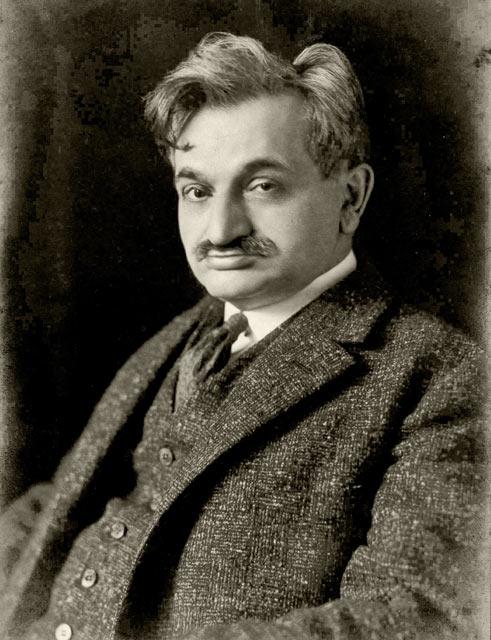
Emanuel Lasker - the second world chess champion
Content
Emanuel Lasker was a German chess player of Jewish origin, philosopher and mathematician, but the world remembers him primarily as a great chess player. He won the world chess title at age 25 by defeating Wilhelm Steinitz and kept it for the next 27 years, the longest in history. He was a supporter of Steinitz's logical school, which, however, he enriched with his philosophy and psychological elements. He was a master of defense and counterattack, very good at chess endings.
1. Emanuel Lasker, source:
Emanuel Lasker was born on Christmas Eve 1868 in Berlinchen (now Barlinek in the West Pomeranian Voivodeship) in the family of the cantor of the local synagogue. The passion for chess was instilled in the future grandmaster by his older brother Berthold. From an early age, Emanuel surprised with his genius, mathematical abilities and absolute mastery in chess. He graduated from high school in Gorzow and in 1888 began to study mathematics and philosophy in Berlin. However, his passion for chess was more important, and that was what he focused on when he dropped out (1).
1894 World Chess Championship match
Match against 58-year-old title defender American Wilhelm Steinitz 25-year-old Emanuel Lasker played in three cities (New York, Philadelphia and Montreal) from March 15 to May 26, 1894. The rules of the match assumed a game up to 10 won games, and a draw was not taken into account as a result. Emanuel Lasker won 10:5(2).
2. Emanuel Lasker (right) and Wilhelm Steinitz in the match for the world title in 1894, source:
Victory and glory did not turn Emanuel's head. In 1899 he graduated in mathematics from the University of Heidelberg, and three years later in Erlangen received a Ph.D.
In 1900-1912 he stayed in England and the USA. At that time, he devoted himself to scientific work in the field of mathematics and philosophy, and in chess activities he was engaged, in particular, editing the Lasker Chess Journal in 1904-1907 (3, 4). In 1911 he married the writer Martha Kohn in Berlin.
3. Emanuel Lasker, source:
4. Lasker's Chess Magazine, cover, November 1906, source:
Lasker's greatest achievements in practical play include victories at major tournaments in London (1899), St. Petersburg (1896 and 1914), and New York (1924).
In 1912 in the fall of 1914, but that match was canceled when the First World War broke out.
In 1921, he lost the world title against Capablanca. A year earlier, Lasker had recognized his opponent as the best chess player in the world, but Capablanca wanted to beat Lasker in an official match.
1921 World Chess Championship match
March 15 - April 28, 1921 in Havana Lasker held a match for the title world champion with Cuban chess player Jose Raul Capablanca. This was the first match after an 11-year hiatus caused by the First World War (5). The match was scheduled for a maximum of 24 games. The winner was to be the player who first achieved 6 wins, and in case no one succeeded, the player with the most points. At first the game went smoothly, but as the tropical Cuban summer began, Lasker's health deteriorated. With the score 5:9 (0:4 not including draws), Lasker refused to continue the match and returned to Europe.
5. Jose Raul Capablanca (left) - Emanuel Lasker in the match for the world title in 1921, source:
6. Emanuel Lasker, source: National Library of Israel, Shwadron collection.
Lasker was known for his psychological methods of play (6). He paid much attention not only next move logicwhat is the psychological recognition of the enemy and the choice of the most uncomfortable tactics for him, contributing to the commission of a mistake. Sometimes he chose theoretically weaker moves, which, however, were supposed to impress the opponent. In the famous game against Capablanca (St. Petersburg, 1914), Lasker was very eager to win, but in order to lull his opponent's vigilance, he chose the opening variation, which was considered a draw. As a result, Capablanca played inattentively and lost.
Since 1927 Lasker was friends with Albert Einsteinwho lived nearby in Berlin's Schöneberg district. In 1928, Einstein, congratulating Lasker on his 60th birthday, called him "a man of the Renaissance." Reflections from the discussions between the brilliant physicist and the best chess player in the world can be found in the preface to the biography of Emanuel Lasker, in which Albert Einstein argued with his friend's views on the speed of light underlying the theory of relativity. I am grateful to this tireless, independent, and modest man for the rich discussions he gave me,” wrote the brilliant physicist in the preface to Lasker's biography.
The cartoon (7) "Albert Einstein meets Emanuel Lasker" by Oliver Schopf was presented at a large exhibition dedicated to the life and chess work of Emanuel Lasker in Berlin-Kreuzberg in October 2005. It has also been published in the German chess magazine Schach.
7. Oliver Schopf's satirical drawing "Albert Einstein meets Emanuel Lasker"
In 1933 Lasker and his wife Martha Cohnboth of Jewish origin were forced to leave Germany. They moved to England. In 1935, Lasker received an invitation from Moscow to come to the Soviet Union, granting him membership in the Moscow Academy of Sciences. In the USSR, Lasker renounced German citizenship and received Soviet citizenship. In the face of the terror that accompanied Stalin's rule, Lasker left the Soviet Union and in 1937, together with his wife, left for New York via the Netherlands. However, he lived in his new homeland for only a few years. He died of a kidney infection in New York on January 11, 1941 at the age of 72 at Mount Sinai Hospital. Lassen was buried at the historic Beth Olom Cemetery in Queens, New York.
A number of opening chess variations are named after him, such as Lasker's variations in the Queen's Gambit (1.d4 d5 2.c4 e6 3.Nc3 Nf6 4.Bg5 Be7 5.e3 0-0 6.Nf3 h6 7.Bh4 N4 ) and the Evans Gambit ( 1.e4 e5 2.Nf3 Nc6 3.Bc4 Bc5 4.b4 G:b4 5.c3 Ga5 6.0-0 d6 7.d4 Bb6). Lasker was an erudite man, Ph.D. with a mathematical faculty, author of scientific dissertations and books, an outstanding expert on the game of GO, an excellent bridge player and co-author of plays.
8. Memorial plaque in Barlinka on the street. Khmelna 7 in memory of Emanuel Lasker,
source:
Barlinek (8, 9), the hometown of the "King of Chess", hosted the International Chess Festival in memory of D. Emanuel Lasker. There is also a local chess club "Lasker" Barlinek.
9. Park them. Emanuel Lasker in Barlinek,
source:
Chess alphabet
bird debut
The bird opening is a valid, though rare, chess opening that starts with 1.f4 (diagram 12). White takes control of the e5-square, gaining an opportunity to attack at the price of a slight weakening of the kingside.
This opening was mentioned by Luis Ramirez de Lucena in his book Repetición de amoresy arte de ajedrez, con 150 juegos de partido (Treatise on love and chess art with one hundred and fifty examples of games), published in Salamanca (Spain). in 1497 (13) . Eight known copies of the original edition have survived to this day.
The leading English chess player of the nineteenth century, Henry Edward Bird (14), analyzed and used this opening in his games from 1855 for 40 years. In 1885, The Hereford Times (a weekly newspaper published every Thursday in Hereford, England) called Byrd's opening the opening move 1.f4, and this name was common. The Danish grandmaster Bent Larsen, the world's leading chess player of the 60s and 70s, was also a supporter of Byrd's opening.
13. A page from the oldest printed chess book, copies of which have survived to this day - Luis Lucena "Repetición de amores y arte de ajedrez, con 150 juegos de partido"
14. Henry Edward Bird, źródło:
The main and most frequently used response in this system is 1..d5 (diagram 15), i.e. the game develops as in the Dutch Defense (1.d4 f5), only with reversed colors, but in this variation of Byrd's opening White has an additional tempo greater than . The best move White has now is 2.Nf3. The knight controls e5 and d4 and does not allow Black to test the king with Qh4. Then one can play, for example, 2… c5 3.e3 Nf6 with an equal position.
15. The main variation in Byrd's opening: 1.f4 d5
International champion Timothy Taylor, in his book on Byrd's opening, believes that the main defensive line is 1.f4 d5 2.Nf3 g6 3.e3 Bg7 4.Ge2 Nf6 5.0-0 0-0 6.d3 c5 (16).
16. Timothy Taylor (2005). Bird Opening: Detailed coverage of White's underrated and dynamic choices
If Black chooses 2.g3, then Black's recommended response is 2…h5! and further, for example, 3.Nf3 h4 4.S:h4 W:h4 5.g:h4 e5 with Black's dangerous attack.
Gambit Fromm
17. Martin Severin From, Source:
Gambit From is a very aggressive opening introduced into tournament practice thanks to the analyzes of the Danish chess master Martin From (17), the creator of the northern gambit.
Frome's Gambit is created after the moves 1.f4 e5 and is one of the most popular continuations of the Bird Opening (diagram 18). Therefore, many players immediately play 2.e4, moving to the King's Gambit, or after accepting the gambit 2.f:e5 d6, they give up a piece by playing 3.Nf3 d:e5 4.e4
In the From Gambit, one must remember to avoid falling into a trap, for example, 1.f4 e5 2.f:e5 d6 3.e:d6 G:d6 (diagram 19) 4.Cc3? He also loses quickly, like 4.e4? Hh4+5.g3 Gg3+6.h:g3 H:g3+7.Ke2 Gg4+8.Nf3 H:f3+9.Ke1 Hg3 # Best 4.Nf3. 4… Hh4 + 5.g3 G:g3 + 6.h:g3 H:g3 #
19. From the gambit, position after 3... H: d6
In the main variation of Frome's Gambit 1.f4 e5 2.f:e5 d6 3.e:d6 G:d6 4.Nf3, future world champion Emanuel Lasker played 4…g5 in the Bird-Lasker game played in Newcastle upon Pona. Tyne in 1892. This variant, also the most commonly used today, is called the Lasker variant. Now White can choose, among other things, the two most frequently used game plans: 5.g3 g4 6.Sh4 or 5.d4 g4 6.Ne5 (if 6.Ng5, then 6…f5 with the threat of h6 and winning the knight).
Emanuel Lasker - Johann Bauer, Amsterdam, 1889
One of the most famous chess games in history was played between them. Emanuel Lasker i Johann Bauer in Amsterdam in 1889. In this game, Lasker sacrificed both of his bishops to destroy the pawns defending the opponent's king.
20. Emanuel Lasker - Johann Bauer, Amsterdam, 1889, position after 13 Ha2
1.f4 d5 2.e3 Nf6 3.b3 e6 4.Bb2 Ge7 5.Bd3 b6 6.Sc3 Bb7 7.Nf3 Nbd7 8.0-0 0-0 9.Se2 c5 10.Ng3 Qc7 11.Ne5 S: e5 12. G: e5 Qc6 13.Qe2 (diagram 20) 13… a6? Wrong decision allowing Lasker to sacrifice messengers. Better was 13… g6 in an equal position. 14.Sh5 Sxh5 15.Hxh7 + White sacrifices the first bishop. 15…K:h7 16.H:h5 + Kg8 17.G:g7 (e.21) 17…K:g7 Refusal to sacrifice the second bishop leads to mate. After 17… f5 comes the 18th Re5 Rf6 19.Ff3 followed by 20.Reg3, and after 17… f6 the 18th or 6th Re18 wins. 3.Qg18 + Kh4 7.Rf19 Black must give up his queen to avoid checkmate. 3… e19 5.Wh20 + Qh3 6.W:h21 + W:h6 6.Qd22 (diagram 7) This move, attacking both black bishops, leads to Lasker's material and positional advantage. 22… Bf22 6.H: b23 Kg7 7.Wf24 Wab1 8.Hd25 Wfd7 8.Hg26 + Kf4 8.fe27 Gg5 7.e28 Wb6 7.Hg29 f6 6.W: f30 + G: f6 6.H: f31 + Ke6 8.Hh32 + Ke8 7.Hg33 + K: e7 6.H: b34 Wd7 6.H: a35 d6 4.e: d36 c: d4 4.h37 d4 3.H: d38 (diagram 3) 23-1.
21. Emanuel Lasker - Johann Bauer, Amsterdam, 1889, position after 17.G: g7
22. Emanuel Lasker - Johann Bauer, Amsterdam, 1889, position after 22Qd7.
23. Emanuel Lasker - Johann Bauer, Amsterdam, 1889, the position in which Bauer surrendered.

